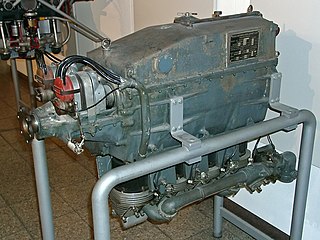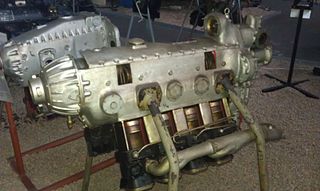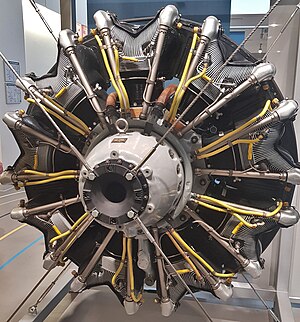Design and development
Development of the 323 was the end result of a series of modifications to the original Jupiter design, which Siemens licensed in 1929. The first modifications produced the Sh.20 and Sh.21. The design was then bored out to produce the 950 hp (708 kW) Sh.22 in 1930. Like the Jupiter, the Sh.22 featured a rather "old" looking arrangement with rather prominent valve pushrods on the front of the engine. In the mid-1930s the Reich Air Ministry (RLM) altered the way in which engines were assigned code names, and Bramo was given the 300-block of numbers. Therefore, the Sh.14 and Sh.22 became the 314 and 322, respectively. The 322 never matured and remained unreliable.
The team continued work on the basic design, adding fuel injection and a new supercharger. The resulting Bramo 323 was just under 27 L in displacement, and produced 900 PS at 2,500 rpm for takeoff, improving slightly to 1,000 PS at 3,100 m (10,200 ft). The reduced power at sea level was inevitable for engines with single-speed, mechanically-driven superchargers when they were regulated to a constant maximum boost pressure below their critical altitude.
The Fafnir powered a number of German prewar designs, including the Focke-Wulf Fw 200, Henschel Hs 126, Dornier Do 24 and Dornier Do 17, as well as the Focke Achgelis Fa 223 Drache helicopter. Its fairly poor fuel economy kept it from more widespread use, and most designs chose the similar BMW 132 instead, whose specific fuel consumption varied between 220 and 240 g/(kW•h) depending on model, whereas the early versions of the Fafnir got about 255 g/(kW•h), a poor figure for the era. The C/Ds, where the supercharger used less power, improved this to 230 g/(kW•h), but were only useful at lower altitudes.
BMW bought Bramo in 1939 and continued production to supply the small number of designs that already used it, notably the Do 17. The naming at this point becomes somewhat confusing, with BMW, Bramo and Fafnir being used almost interchangeably depending on the source. 5,500 were produced before the lines were shut down in 1944.
The original 323 design was produced in A and B models, differing in the direction they turned. The engines were intended to be installed in A/B pairs, thereby eliminating engine torque across a twin-engine aircraft. The similar C and D models featured a lower supercharger gearing for better performance at lower altitudes, improving takeoff power to 1,000 PS, but reducing the critical altitude.
The final versions, P, R and T, featured a two-speed supercharger for better all-around performance. This allowed it to generate 1,000 PS at sea level as in the C/D models, but improved altitude performance considerably, delivering 940 PS at 4,000 m (13,000 ft). The R-2 subtype added MW 50 water-methanol injection for added low-altitude performance, boosting power to 1,200 PS at 2,600 rpm.

The BMW 801 was a powerful German 41.8-litre (2,550 cu in) air-cooled 14-cylinder-radial aircraft engine built by BMW and used in a number of German Luftwaffe aircraft of World War II. Production versions of the twin-row engine generated between 1,560 and 2,000 PS. It was the most produced radial engine of Germany in World War II with more than 61,000 built.

The Focke-Wulf Fw 44 Stieglitz ("Goldfinch") is a 1930s German two-seat biplane. An early design by Kurt Tank, it was produced by the Focke-Wulf company as a pilot training and sports flying aircraft. It was also built under license in several other countries.

The Jumo 205 aircraft engine was the most famous of a series of aircraft diesel engines produced by Junkers. The Jumo 204 first entered service in 1932. Later engines of this type comprised the experimental Jumo 206 and Jumo 208, with the Jumo 207 produced in some quantity for the Junkers Ju 86P and -R high-altitude reconnaissance aircraft, and the 46-meter wingspan, six-engined Blohm & Voss BV 222 Wiking flying boat. All three of these variants differed in stroke and bore and supercharging arrangements. In all, more than 900 of these engines were produced, in the 1930s and through most of World War II.

The Jumo 211 was a German inverted V-12 aircraft engine, Junkers Motoren's primary aircraft engine of World War II. It was the direct competitor to the Daimler-Benz DB 601 and closely paralleled its development. While the Daimler-Benz engine was mostly used in single-engined and twin-engined fighters, the Jumo engine was primarily used in bombers such as Junkers' own Ju 87 and Ju 88, and Heinkel's H-series examples of the Heinkel He 111 medium bomber. It was the most-produced German aero engine of the war, with almost 70,000 examples completed.

The Daimler-Benz DB 601 was a German aircraft engine built during World War II. It was a liquid-cooled inverted V12, and powered the Messerschmitt Bf 109, Messerschmitt Bf 110, and many others. Approximately 19,000 601's were produced before it was replaced by the improved Daimler-Benz DB 605 in 1942.

The Junkers Jumo 213 was a World War II-era V-12 liquid-cooled aircraft engine, a development of Junkers Motoren's earlier design, the Jumo 211. The design added two features, a pressurized cooling system that required considerably less cooling fluid which allowed the engine to be built smaller and lighter, and a number of improvements that allowed it to run at higher RPM. These changes boosted power by over 500 hp and made the 213 one of the most sought-after Axis engine designs in the late-war era.

The BMW 132 was a nine-cylinder radial aircraft engine produced by BMW starting in 1933.

The Daimler-Benz DB 600 was a German aircraft engine designed and built before World War II as part of a new generation of German engine technology. It was a liquid-cooled inverted V12 engine, and powered the Messerschmitt Bf 110 and Heinkel He 111 among others.

The Daimler-Benz DB 605 is a German aircraft engine built during World War II. Developed from the DB 601, the DB 605 was used from 1942 to 1945 in the Messerschmitt Bf 109 fighter, and the Bf 110 and Me 210C heavy fighters.

The Daimler-Benz DB 603 was a German aircraft engine used during World War II. It was a liquid-cooled 12-cylinder inverted V12 enlargement of the 33.9 Liter DB 601, which was in itself a development of the DB 600. Production of the DB 603 commenced in May 1942, and with a 44.5 liter displacement figure, was the largest displacement inverted V12 aviation engine to be produced and used in front line aircraft of the Third Reich during World War II.

The Flettner Fl 282 Kolibri ("Hummingbird") is a single-seat intermeshing rotor helicopter, or synchropter, produced by Anton Flettner of Germany. According to Yves Le Bec, the Flettner Fl 282 was the world's first series production helicopter.

The Argus As 8 was a four-cylinder, air-cooled, inverted inline aircraft engine produced in Germany by Argus Motoren in the 1930s.

The Hirth HM 508 was an air-cooled, eight-cylinder, 60° cylinder bank angle inverted-V aircraft engine built in Germany in the 1930s. It had a bore and stroke of 105 mm × 115 mm and developed 210 kW (280 hp) at 3,000 rpm.

The Hirth HM 504 is a four-cylinder air-cooled inverted inline engine. The HM 504 was a popular engine for light aircraft of the 1930s-1940s, and it was used to power a number of Germany's trainer aircraft of World War II. The engine featured a cast magnesium alloy crankcase made of Elektron The Hitachi Hatsukaze Model 11 was a Japanese licensed version.
The Siemens-Halske Sh 22 was a nine-cylinder aircraft radial engine manufactured by Siemens & Halske in Germany in the 1930s. Following the reorganization of its manufacturer and change in military nomenclature, the engine became known as the Bramo 322.
The Hirth HM 512 was a 12-cylinder development of the earlier, 6-cylinder HM 506, produced in the late 1930s. Both were supercharged, inverted V, air-cooled engines.
The Arado Ar 69 was a two-seat German beginner's school and sport biplane with an open cockpit, developed in 1933 by Arado Flugzeugwerke.

The SNECMA 14R was a 14-cylinder two-row air-cooled radial engine developed in France just prior to the start of World War II from the Gnome-Rhône 14N. The 14N radial engine was itself an improved version of the popular pre-war Gnome-Rhône 14K Mistral Major series; designed and manufactured by Gnome et Rhône, a major French aircraft engine manufacturer whose origins pre-date the First World War.

The Zündapp 9–092 or Z 92 was a German four-cylinder, air-cooled, inline aero engine made by Zündapp and used in light aircraft of the late-1930s.
The Hirth HM 501 was a 6-cylinder air-cooled inverted in-line engine that was developed by Hirth Motoren GmbH in the late 1930s, from the 4-cylinder HM 500 and used principally on the submarine-born Arado Ar 231.
















